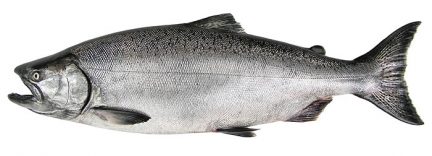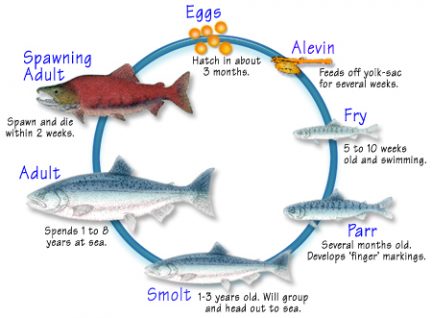The Oregon coastline stretches 363 miles, making it an ideal location to catch the bounty of the Pacific. At any port, boats come in and out all day long, off to find fish, shrimp, crabs, and other shellfish. In 2020, over 1.5 million pounds were landed, or caught and brought to shore, worth over $5 million.1
Long before Lewis and Clark came west looking for the Great Northwest Passage, many Native American tribes living on coastal Oregon fished the seas for food. The most common way to fish was with purse seines, horizontal nets that have floats holding the tip line of the new at the water’s surface, and weights at the bottom of the net. When the weighted line was pulled, the net would close like a purse. As settlers moved into the Oregon territory, they too looked to the seas as a source of food. The most famous fish in Oregon is the salmon, and that is where the Oregon fishing industry all began.
The first fishing industry in Oregon was for salmon in the Columbia River. By the mid 1800’s, the commercial salmon industry took off with the help of the canning industry; before that, fish was salted and packed into barrels, but it didn’t travel to well. Once salmon could be canned, the number of fishing boats operating in the Columbia jumped from 100 to 1,200 in nine years. The peak year for salmon harvest was 1911, when 49.5 million pounds were harvested. Salmon numbers began to dwindle after that for many reasons; two big reasons were dams were being placed on traditional breeding grounds, so the salmon could not return to spawn, and salmon were being over-fished in general because it was thought that there was an infinite number of fish available to catch. There were many attempts to regulate salmon fishing, but it wasn’t until the mid-20th century that legislation was put in place to reduce over-fishing. Today the Pacific Fishery Management Council sets the fishing seasons.

The chinook salmon rears in the Pacific Ocean for most of its life and spawns in freshwater streams. The majority of mature chinook salmon enter Oregon coastal rivers from about April through December. Spring chinook begin entering the Columbia River in February. Entry into most Oregon rivers reaches a low point in summer. Different populations of chinook salmon in a basin can be distinguished by the season of the year during which they return to fresh water since fish with different run timings tend to spawn in different parts of the basin and thus maintain some reproductive isolation. Such populations in Oregon rivers are usually called either spring or fall chinook, although several populations could legitimately be described as summer or winter chinook. Spawning generally occurs from August to early November for spring chinook and from October to early March for fall chinook. All adults die within two weeks after spawning.

The coho salmon rears for part of its life in the Pacific Ocean and spawns in freshwater streams. Mature fish migrate into fresh water in the fall, typically spawning from November through February. They may spend several weeks to several months in fresh water before spawning, depending on the distance they migrate to reach their spawning grounds. All adults die within two weeks after spawning. Juveniles normally spend one summer and one winter in fresh water, although they may remain for one or two extra years in the coldest rivers in their range. They migrate to the ocean in the spring, generally one year after emergence, as silvery smolts about four to five inches long. Initial ocean migration off Oregon appears to be to the north of their natal streams, but as they mature during their second summer in the ocean they are found predominantly off the coasts of California and Oregon to the south of their natal streams. Maturing coho from Oregon are rarely caught north of the U.S. border. Most adults mature at 3 years of age, but some males mature as 2–old “jacks” or “precocious males.” Coho adults rarely exceed 15 pounds.

The chum salmon rears in the Pacific and Arctic oceans and spawns in freshwater streams. Most of the chum salmon life span is spent in a marine environment. Adults typically enter spawning streams ripe, promptly spawn, and die within two weeks of arrival. Most spawning runs are over a short distance. Adults are strong swimmers, but poor jumpers and are restricted to spawning areas below barriers, including minor barriers that are easily passed by other anadromous species. Juveniles are intolerant of prolonged exposure to fresh water and migrate to estuarine waters promptly after emergence. Chum salmon mature at 2 to 6 years of age and may reach sizes over 40 pounds.
All three of the above mentioned salmon have similar life cycles. The video below, produced by Oregon Department of Fish and Wildlife, details the life cycle of salmon (length: 6 minutes).

Eggs are laid in freshwater streams and rivers. The females lays her eggs during the fall in a redd, a nest in the gravel, and the males fertilize them. Embryos develop during the winter and hatch in the spring.

Alevins are the baby fish right after they hatch. the yolk sac of the egg is still attached to their belly; this will be their food source for the next few months while the are still in the redd. After all of the yolk sac is eaten, the fish leave the redd and become fry.

Fry will spend the next year or so of their life in the stream, eating and growing in size. The length of time spent in the stream depend on what species they are: chum head directly to the sea once, chinook hang out for five months, and coho spend the most time in freshwater at a year.

After spending their time in freshwater, environmental cues spark salmon to head to the ocean. This is called smolting, when the salmon turn a silvery color and head to the ocean. Once they reach the estuaries, smolt acclimate to their new salty home and feed heavily to better their chances of surviving in the ocean.

Salmon can spend the next one to seven years in the ocean, depending on the species. During that time, they migrate looking for food and grow.

After a certain amount of time, salmon get the urge to return to where they hatched to spawn and start the cycle again. Once the salmon return to freshwater they stop eating, so it is important to move quickly. Once they reach their destination, the females builds her redd. She does this by turning on her side and moving stones and pebbles. Once the redd is made, males fight to spawn with the female; after a mate has been chosen, the eggs and milt are released at the same time, and the fertilized eggs fall into the redd. The female cover the nest with gravel. This process is repeated until the female dies, which is around two weeks after the first mating.
In Oregon, there are two places to commercially catch salmon: in the ocean and the Columbia River. In the ocean, salmon are caught by trolling. Trolling is when a line is slowly dragged through the water with a baited hook or lure. Salmon boats can have multiple trolling lines attached, and they utilize outriggers to make sure the lines do not tangle. The lines are drawn through the ocean at different speeds, depending on which species of salmon is the target. After the salmon are caught, they are dressed, which means to take the internal organs out, and packed on ice.
Commercial fishing in the Columbia River is a little different. There are two methods used in the Columbia: purse seining and gillnetting. Purse seining uses a large net to encircle fish and then close around them. Gillnetting is a type of straight net that is set up in the path of salmon returning to spawn. The net is kept afloat by corks at the top. Salmon swim into the net and get trapped in the holes, which are a specific size for the desired species. Like trolling, once the fish are caught, they are dressed and packed in ice.
Once the fish are caught, they are taken to a processor to be cut up into the various products.
The number one use of salmon is for human consumption; after the fish are harvested, they can be cut into fillets, canned, smoked, be made into salmon patties, or left raw for sushi and other raw preparations. There are many other uses for salmon besides human consumption. The main byproduct is fish meal. After the good meat is taken off of the fish, only the head, internal organs, bones and tail are left, which are ground up and made into fish meal. Fish meal can be found in some animal feeds and pet foods. Another byproduct is fish oil made from the heads of salmon.
Salmon can be harvested from wild fisheries or farm raised. Wild caught salmon are one of the five Pacific salmon species, while farmed raised salmon are Atlantic salmon. Farmed salmon are hatched, raised and harvested under controlled conditions, and are available fresh year-round; the best time to buy fresh wild caught salmon is June through September.
the process of removing the internal organs once a fish has been caught
the place where a freshwater body (like a river) meets the ocean
the length of time fish can be caught commercially, normally lasting a few months each year
a type of net that hangs straight down in the water
when a fish is caught and brought to shore
male fish sperm
a type of net that when pulled close like a purse to catch the fish
a salmon egg nest
the process of salmon turning a silvery color and head to the ocean
when a female fish releases her eggs
a type of fishing that uses long lines to catch the fish